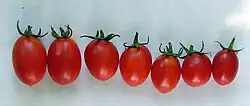Pomodorino di Manduria
| Pomodorino di Manduria | |
|---|---|
 | |
| Tomato (Solanum lycopersicum) | |
| Color | Red |
Pomodorino di Manduria is an ecotype of tomato typical of Manduria, Apulia.
Characteristics
These tomatoes are cultivated in little plots of land (1/2–2 hectares). They are sown in March and harvested from the second half of June to the first days of September.[1]
From some researches, it has been discovered that this ecotype is very resistant to the tomato spotted wilt orthotospovirus (TSWV) and with a graft that this tolerance is also transmitted to other varieties.[2][3]
This table is about dried tomatoes in oil (for 100 grams):
| Water | Protein | Fat | Carbohydrate | Fiber | Energy Value |
|---|---|---|---|---|---|
| 57 | 5 | 14 | 17 | 5 | 214 kcal[4] |
Designation of origin
The Italian Ministry of Agricultural, Food and Forestry Policies has recognised pomodorino di Manduria as a prodotto agroalimentare tradizionale (PAT) of Apulia.[5]
See also
References
- ^ "Manduria Cherry Tomato". fondazioneslowfood.com. Retrieved 10 December 2024.
- ^ Spanò, Roberta; Mascia, Tiziana; Kormelink, Richard; Gallitelli, Donato (2015-10-23). "Grafting on a Non-Transgenic Tolerant Tomato Variety Confers Resistance to the Infection of a Sw5-Breaking Strain of Tomato spotted wilt virus via RNA Silencing". PLOS ONE. 10 (10): e0141319. Bibcode:2015PLoSO..1041319S. doi:10.1371/journal.pone.0141319. ISSN 1932-6203. PMC 4619829. PMID 26496695.
- ^ "Pomodoro di Manduria tollerante al Tomato Spotted Wilt Virus". BiodiverSO (in Italian). 2014-08-18. Retrieved 2018-08-03.
- ^ Regione Puglia, Assessorato Risorse Agroalimentari (2006). Atlante dei prodotti tipici agroalimentari di Puglia. Modugno (Bari): Edit. p. 91.
- ^ Tredicesima revisione dell'elenco dei prodotti agroalimentari tradizionali Archived 27 September 2013 at the Wayback Machine (in Italian). Rome: Ministero delle politiche agricole alimentari e forestali. Accessed June 2014.